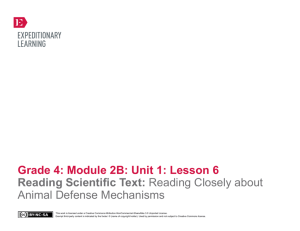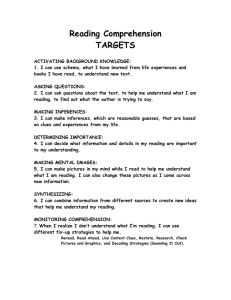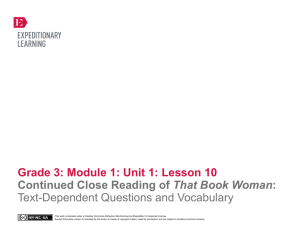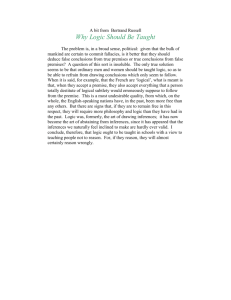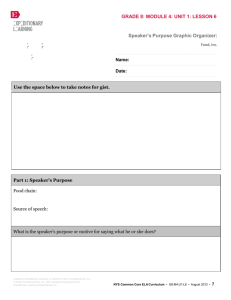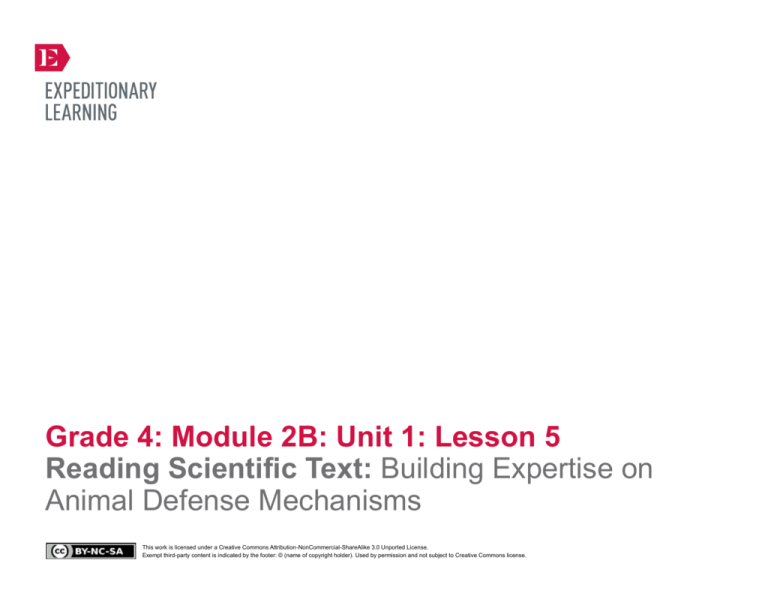
Grade 4: Module 2B: Unit 1: Lesson 5
Reading Scientific Text: Building Expertise on
Animal Defense Mechanisms
This work is licensed under a Creative Commons Attribution-NonCommercial-ShareAlike 3.0 Unported License.
Exempt third-party content is indicated by the footer: © (name of copyright holder). Used by permission and not subject to Creative Commons license.
GRADE 4: MODULE 2B: UNIT 1: LESSON 5
Reading Scientific Text:
Building Expertise on Animal Defense Mechanisms
Long-Term Targets Addressed (Based on NYSP12 ELA CCLS)
I can paraphrase portions of a text that is read aloud to me. (SL.4.2)
I can interpret information presented through charts or graphs. I can explain how that information helps me understand the text around it. (RI.4.7)
I can determine the main idea using specific details from the text. (RI.4.2)
Supporting Learning Targets
Ongoing Assessment
• I can paraphrase information presented in a read-aloud on animal defense mechanisms.
• Listening Closely note-catcher (page 7 of Animal
Defenses research journal)
• I can make inferences about animal defense mechanisms by examining articles that include text and
visuals.
• I can determine the main idea of a section of Animal Behaviors: Animal Defenses.
• Examining Visuals note-catcher (page 8 of Animal
Defenses research journal)
• Determining Main Ideas note-catcher (pages 9 and 10 of
Animal Defenses research journal)
• Observation of participation during Jigsaw
Copyright © 2013 by Expeditionary Learning, New York, NY. All Rights Reserved.
NYS Common Core ELA Curriculum • G4:M2B:U1:L5 • June 2014 •
1
GRADE 4: MODULE 2B: UNIT 1: LESSON 5
Reading Scientific Text:
Building Expertise on Animal Defense Mechanisms
Agenda
Teaching Notes
Opening
• During the Opening of this lesson, students listen and take notes as a section in Venom titled, “A Meal to
Remember,” is read aloud. Note that in Unit 2 students will reread this excerpt of as a part of their mid
and end of unit assessment. Students will need to reference their notes on this section of the text during
these assessments, so be sure they keep their notes.
A. Engaging the Reader: Read-aloud of Venom (10
minutes)
B. Reviewing Learning Targets (5 minutes)
Work Time
A. Examining Visuals (20 minutes)
B. Rereading an Informational Text: Determining the
Main Idea (20 minutes)
Closing and Assessment
C. Animal Defense Mechanisms: KWL Chart (5
minutes)
Homework
A. Continue your independent reading.
• Students begin the same process used in Lessons 2–4 to closely read a section of the central text Animal
Behavior: Animal Defenses. They examine a visual and think about how it helps them better
understand the text, then read and reread the same section for the main idea and supporting details.
This process continues into Lesson 6.
• Students will use the Jigsaw protocol to read the predetermined sections in Animal Behavior: Animal
Defenses. In Lesson 5, they work with their expert groups to closely examine a visual and determine the
main idea of their section. In Lesson 6, they will continue working in these groups to identify details that
support that main idea, and then will meet with students who read different sections of the text to share
the main idea and supporting details.
• The four sections from Animal Behavior: Animal Defenses that students work with in Lessons 5 and 6
were chosen based on the overall structure of the book. By reading these specific sections, students will
get a general overview of what animal defense mechanisms are as well as an introduction to several
types of defense mechanisms (chemical defenses and warning colors, venom, and mimicry).
• Since one section is about venom, which has been discussed in previous lessons, consider assigning this
section to students who are struggling. The background knowledge they have built in Lessons 1–4 will
support them in tackling this text.
• In advance: Determine expert groups for Jigsaw protocol (three groups total).
• Review: Jigsaw protocol (see Appendix).
• Post: Learning targets.
Copyright © 2013 by Expeditionary Learning, New York, NY. All Rights Reserved.
NYS Common Core ELA Curriculum • G4:M2B:U1:L5 • June 2014 •
2
GRADE 4: MODULE 2B: UNIT 1: LESSON 5
Reading Scientific Text:
Building Expertise on Animal Defense Mechanisms
Lesson Vocabulary
Materials
determine, camouflage, mimicry
• Venom (book for teacher read-aloud, pages 74–75)
• Document camera
• Animal Defenses Research Journal (from Lesson 1)
• Listening Closely note-catcher (page 7 of Animal Defenses research journal; one per student and one to display)
• Listening Closely note-catcher (completed, for teacher reference)
• Equity sticks
• Animal Behavior: Animal Defenses (book; one per student and one to display)
– Teacher model—“Avoiding Danger” (pages 7–9, stopping at “Self-Defense”; last 2 paragraphs on page 21; “Escape Artists”
first two paragraphs on page 22)
– Group 1—“Bad Smells, Bad Tastes, and Powerful Poisons” (page 55–top of 56, stopping at “Poisonous Prey”; pages 58–
60)
– Group 2—“Venomous Stings and Bites” (page 83; “How Venom Works” box on page 86; “Stinging Tentacles” pages 77–
78)
– Group 3—“Mimicry” (pages 91–94)
• Examining Visuals note-catcher (page 8 of Animal Defenses research journal; one per student and one to display)
• Examining Visuals note-catcher (completed, for teacher reference)
• Sticky notes
• Determining the Main Idea note-catcher (pages 9 and 10 of Animal Defenses research journal; one per student and one to
display)
• Determining the Main Idea note-catcher (completed, for teacher reference)
• Animal Defense Mechanisms: KWL Chart (page 1 of Animal Defenses research journal; from Lesson 1; one per student and
one to display)
Copyright © 2013 by Expeditionary Learning, New York, NY. All Rights Reserved.
NYS Common Core ELA Curriculum • G4:M2B:U1:L5 • June 2014 •
3
GRADE 4: MODULE 2B: UNIT 1: LESSON 5
Reading Scientific Text:
Building Expertise on Animal Defense Mechanisms
Opening
Meeting Students’ Needs
A. Engaging the Reader: Read-aloud of Venom (10 minutes)
• Display the cover of Venom so all students can see. Open to pages 26 and 27 and ask:
• Whole class discussions encourage
respectful and active listening, as
well as social construction of
knowledge.
* “What did we learn about animal defense mechanisms when we read aloud Venom a few days ago?”
• Listen for responses like: “Fire ants sting their enemies to defend themselves.” Validate responses and explain to students
that they will be listening to another section of Venom today.
• Using a document camera, display blank Listening Closely note-catcher and invite students to open to the next one
on page 7 in their Animal Defenses research journals. Remind students that they have been using this note-catcher to
record information heard during a read-aloud.
• Use equity sticks to call on students. Review how to use the note-catcher by asking:
* “What kind of information do we record in each part of this note-catcher?”
• Listen for responses like: “We record facts about ants in the first column, how ants protect themselves in the middle column,
and explain how that helps the ant survive in the right-hand column. We write a gist statement at the bottom.”
• Remind students that they will listen to a new part of Venom read aloud several times. Remind them that the first time they
hear it, they should simply listen to what is being read. The second time they hear it read, they should begin to fill in the
table.
• Hearing a complex text read slowly,
fluently, and without interruption or
explanation promotes fluency for
students; they are hearing a strong
reader read the text aloud with
accuracy and expression, and are
simultaneously looking at and
thinking about the words on the
printed page. Be sure to set clear
expectations that students read
along silently in their heads as you
read the text aloud.
• Read aloud the section “A Meal to Remember—If You Live That Long” on pages 74 and 75. Do not read the other sections:
“Danger Down Below” or “And Now for Something Completely Different.”
• Invite students to turn and talk with a neighbor, sharing one interesting thing they heard during the read-aloud. Use equity
sticks to call on two students to share what their partners found interesting.
• Tell students that they will now hear pages 74 and 75 read aloud a second time and should now record notes in the notecatcher.
• Read aloud pages 74 and 75 in Venom, stopping briefly after each paragraph. If necessary during each short pause, remind
students to fill in notes on their note-catchers.
• Invite students to turn and talk with a partner. Ask:
* “What is an example of how pufferfish protect themselves?”
Copyright © 2013 by Expeditionary Learning, New York, NY. All Rights Reserved.
NYS Common Core ELA Curriculum • G4:M2B:U1:L5 • June 2014 •
4
GRADE 4: MODULE 2B: UNIT 1: LESSON 5
Reading Scientific Text:
Building Expertise on Animal Defense Mechanisms
Opening (continued)
Meeting Students’ Needs
• Listen for responses like: “They inflate themselves so they are too large to swallow.”
• Discussing and clarifying the
language of learning targets helps
build academic vocabulary.
• Ask:
* “What was the gist of this section?”
• Listen for responses like: “This section was mostly about how pufferfish protect themselves by inflating or by their poison.”
• Point to the question below the table on the graphic organizer—“Explain in your own words what this section of Venom was
about?” Tell students to jot down the gist of this part of the text on these lines. If necessary, prompt students by asking:
“What was this part of the text mostly about?”
• Remind students they will have many more opportunities to read this book, and can read through it on their own during
independent reading or in their free time during the school day if they wish
B. Reviewing Learning Targets (5 minutes)
• Discussing and clarifying the
language of learning targets helps
build academic vocabulary.
• Use equity sticks to call on a student to read the remaining learning targets:
– “I can paraphrase information presented in a read-aloud on animal defense mechanisms.”
– “I can make inferences about animal defense mechanisms by examining articles that include text and visuals.”
– “I can determine the main idea of a section of Animal Behaviors: Animal Defenses.”
• Tell students that they will begin reading a new text about animal defense mechanisms. Build up the excitement!
Copyright © 2013 by Expeditionary Learning, New York, NY. All Rights Reserved.
NYS Common Core ELA Curriculum • G4:M2B:U1:L5 • June 2014 •
5
GRADE 4: MODULE 2B: UNIT 1: LESSON 5
Reading Scientific Text:
Building Expertise on Animal Defense Mechanisms
Work Time
Meeting Students’ Needs
A. Examining Visuals (20 minutes)
• The teacher may offer selected
shorter passages to specific groups
based on the readiness and needs of
the group. This provides an
opportunity for students to read a
complex text within the fourthgrade level span, but differentiates
the length of the text, not the
complexity.
• Distribute copies of Animal Behavior: Animal Defenses. Invite students to flip through the book and Think-PairShare, discussing what they notice and wonder about the book.
• Use equity sticks to call on students to share their observations and questions. Listen for students sharing observations
about the parts of the book like the table of contents, glossary, and index and point out these parts if students do not share
them on their own. Only answer clarifying questions for now; for other questions, respond with something like: “You’ll find
that out as you read this book and work with it more closely throughout this module.”
• Preview Lessons 5 and 6: Tell students that they are going to go through the same process they just went through in reading
“Award-Winning Survival Skills” to closely read and reread sections of this book in order to learn more about animal defense
mechanisms. Explain that they will begin by examining visuals and reading sections for the gist, and then reread for the
main idea and supporting details. They will work in expert groups to read specific sections and then, in the next lesson, share
what they have learned from that section in Jigsaw groups.
• Tell students that today, they will start by examining a visual in a section of the book using the Examining Visuals notecatcher (page 8 of their research journals) to record information and inferences about the visual their group is examining
closely. Remind students that they did this in Lesson 2. Display a copy of the note-catcher and invite students to turn to the
Examining Visuals note-catcher on page 8 of their research journals.
• Briefly review Steps 1–3 and the first two columns on the note-catcher. Clarify that students will complete only the first two
columns prior to reading their section of text. Review Steps 4 and 5 and the heading of the last column (“Details in the Text
That Support My Inferences”). Clarify that students will read their section of the text and then complete the last column.
• Graphic organizers and recording
forms engage students more actively
and provide the necessary
scaffolding that is especially critical
for learners with lower levels of
language proficiency and/or
learning. For students needing
additional support, provide a
partially filled-in graphic organizer.
• Explain to students that before they break into groups to do this, they will practice while looking at a visual in the text
together.
• Provide ELLs with a sentence
starter or frame to aid in language
production. For example: In the
visual I see …
• Invite students to turn to page 8 in the book and examine the photograph and caption, thinking about what details they
notice. Use equity sticks to call on three to four students to share their observations. Listen for things like: “I noticed that
this is also a photograph of a springbok,” or “The springbok bounces into the air with stiff legs to show predators they are
hard to catch.” Add students’ observations to the “Details from the Visual” column. Tell students not to write anything on
their graphic organizers.
• Some students may benefit from
having key sections pre-highlighted
in their texts. This will help them
focus on small sections rather than
scanning the whole text for answers.
• Point to Step 3 on the graphic organizer and explain to students that now they will use the details they observed in the visual
and their background knowledge to make inferences about the springbok.
Copyright © 2013 by Expeditionary Learning, New York, NY. All Rights Reserved.
NYS Common Core ELA Curriculum • G4:M2B:U1:L5 • June 2014 •
6
GRADE 4: MODULE 2B: UNIT 1: LESSON 5
Reading Scientific Text:
Building Expertise on Animal Defense Mechanisms
Meeting Students’ Needs
Work Time (continued)
• Invite students to Think-Pair-Share. Ask:
* “What do you infer about the springbok? What details from the visual did you base your inference on?”
• Once students have had time to discuss their inferences, use equity sticks to call on students to share an inference. Tell
students to use the sentence frame: “We infer _______ because the visual/caption shows/says _______.” Record what
students share in the “My Inferences” column on the graphic organizer.
• If necessary, model briefly. Say something like: “I infer that the springbok’s jumping shows it’s hard to catch because the
predator can see its muscles and see how quick it is. I infer this because the visual shows the springbok’s leg muscles and the
caption says ‘hard to catch,’ which means they must be fast.” [Write inference in the “My Inferences” column.]
• Point to the note on the graphic organizer and remind students that they will not be filling in the right-hand column yet.
Explain that now they will listen to the text read aloud, listening for details that support their inferences.
• Read aloud pages 7–9, the last two paragraphs on page 21, and the first two paragraphs on page 22. Invite students to follow
along in their copies of the text as you read, placing a sticky note in the text by details that support their inferences.
• After reading, ask:
* “What details support our inferences about the springbok?”
• Listen for responses like: “On page 8 it says, ‘Their odd jumping behavior, called stotting, signals to the cheetah, ‘We have
seen you, so do not bother to chase us—we are strong and healthy and can outrun you.’” Model writing details on the notecatcher, including the page number after each detail.
• Tell students that now they will do this in small groups. Break students into three groups. Tell students to circle their group
page assignments on the note-catcher for Steps 1 and 4.
• Ask students to review what it looks like and sounds like when working in a small group of peers. Listen for responses like:
“Wait my turn to speak, so I am heard; don’t shout/speak too loudly; make sure everyone gets a turn to speak; no one person
does most/all of the speaking; use information from text to support my ideas.”
• Prompt students through the steps by inviting them to turn to the visual for their group (the assigned page in Step 1—group 1
turns to page 59, group 2 turns to page 78, and group 3 turns to page 92).
Copyright © 2013 by Expeditionary Learning, New York, NY. All Rights Reserved.
NYS Common Core ELA Curriculum • G4:M2B:U1:L5 • June 2014 •
7
GRADE 4: MODULE 2B: UNIT 1: LESSON 5
Reading Scientific Text:
Building Expertise on Animal Defense Mechanisms
Meeting Students’ Needs
Work Time (continued)
• Tell students to independently examine the photograph and caption, thinking about what details they notice and writing
them in the “Details from the Visual” column on their note-catcher. After several minutes, invite students to share what they
wrote in that column with their partners. Listen for students following class norms when working in a group and identifying
explicit details from the picture when sharing their notes. Support students who rated themselves with a fist, one finger, or
two fingers during the Fist-to-Five for this target in Lesson 2.
• After several minutes, point to Step 3 on the graphic organizer and remind students that now they will use the details they
observed in the visual and their background knowledge to make inferences about the animal in their group’s visual.
• Invite students to think to themselves for a minute before sharing with their group. Ask:
* “What do you infer about the animal in your visual? What details from the visual did you base your inference on?”
• Once students have had some time to discuss their inferences, invite students to write their inferences on their notecatchers. Tell students to use the sentence frame: “We infer _______ because the visual/caption shows/says _______.”
Circulate and support students as necessary, paying special attention to students who rated themselves with a fist, one
finger, or two fingers during the Fist-to-Five for this target in Lesson 2.
• Remind students that they will be filling in the right-hand column after reading their section of the text.
• Tell students that the text is challenging and may have many unfamiliar words. Reassure them that just like when they read
“Award-Winning Survival Skills,” they are not expected to understand it fully the first time they read it. Remind them that
one key to being a strong reader of difficult text is being willing to struggle.
• Remind them that when readers read a text, they use many strategies to make sense of what is being read. Ask:
* “What strategies do readers use to make sense of a text?”
• Listen for responses like: “Readers infer,” or “Readers pay attention to what they understand and what they don’t.” Validate
responses and write this question on the board:
* “When you read this text for the first time, what made sense? What didn’t?”
• Tell students to jot down their notes about what made sense on a sticky note and what is confusing on another sticky note.
• Give students 6–8 minutes to read their section of the text independently. Circulate to support as needed. Probe by asking:
“What’s making sense? What is confusing?” and encourage them to persist. Support students who rated themselves with a
fist, one finger, or two fingers during the Fist-to-Five for this target in Lesson 2.
Copyright © 2013 by Expeditionary Learning, New York, NY. All Rights Reserved.
NYS Common Core ELA Curriculum • G4:M2B:U1:L5 • June 2014 •
8
GRADE 4: MODULE 2B: UNIT 1: LESSON 5
Reading Scientific Text:
Building Expertise on Animal Defense Mechanisms
Meeting Students’ Needs
Work Time (continued)
• After 6–8 minutes, invite students to share initial thinking in their small groups:
* “What makes sense? What is confusing?”
• Then ask them to reread their section of the text together, looking for details that support their inferences about the visual
examined earlier. Ask students to record these details in the right-hand column of their note-catchers, including the page
number where they found that detail. Circulate to support as needed. Probe by asking: “What details support your inferences
about the visual?” or “How does that detail support your inference?” Support students who rated themselves with a fist, one
finger, or two fingers during the Fist-to-Five for this target in Lesson 2.
• Use the Fist-to-Five Checking for Understanding technique to have students briefly reflect on the learning target: “I can
make inferences about animal defense mechanisms by examining an article that includes text and visuals,” with a fist being
“I am not confident that I can meet this target on my own” and a five being “I can make inferences about articles that include
texts and visuals on my own.” Note students who show a fist, one, or two fingers to provide further support in future lessons.
Copyright © 2013 by Expeditionary Learning, New York, NY. All Rights Reserved.
NYS Common Core ELA Curriculum • G4:M2B:U1:L5 • June 2014 •
9
GRADE 4: MODULE 2B: UNIT 1: LESSON 5
Reading Scientific Text:
Building Expertise on Animal Defense Mechanisms
Work Time (continued)
Meeting Students’ Needs
B. Rereading an Informational Text: Determining the Main Idea (20 minutes)
• Tell students they will now reread their section of Animal Behavior: Animal Defenses a second time to determine the main
idea of their section. Invite students to open to pages 9 and 10 in their research journals, to the Determining the Main
Idea note-catcher.
• The teacher may offer selected
shorter passages to specific groups
based on the readiness and needs of
the group. This provides an
opportunity for students to read a
complex text within the fourthgrade level span, but differentiates
the length of the text, not the
complexity.
• Explain that students will continue to work with their expert groups and determine the main idea of their section and that in
the next lesson, they will reread to identify details that support the main idea of their section. Ask:
* “How do we determine the main idea of a section of text?”
• Listen for students describing the process introduced in Lesson 3, saying things like: “We read the text paragraph by
paragraph, and after each paragraph ask ourselves, ‘What is this text about?’ We revise our thinking about the main idea as
we read.”
• Tell students they will then write the main idea in the box for their section only. Explain that they should leave the other
sections blank for now, and the “Supporting Details” boxes blank for now as well.
• Review determining the main idea of “Avoiding Danger” (pages 7–9, the last two paragraphs on page 21, and the first two
paragraphs on page 22) and going through the process just discussed. Have students turn and talk after each paragraph
before discussing the main idea or revised thinking with the whole group. Model recording the main idea in the appropriate
box on the Determining the Main Idea note-catcher and ask students to do the same.
• Review working in a small group by asking:
* “What does it look like or sound like when working in a small group with your peers?”
• Listen for responses like: “Wait my turn to speak, so I am heard; don’t shout/speak too loudly; make sure everyone gets a
turn to speak; no one person does most/all of the speaking; use information from text to support my ideas.”
• Give students 15 minutes to work through the steps with their partners to determine the main idea of their section. Circulate
and support as needed. Listen for students using the steps to determine the main idea of the text and following class norms
when working in a small group. Probe by asking: “What was this section mostly about?” or “How does everything fit together
into the one most important idea?”
• After 15 minutes, invite students to show a thumbs-up if they were able to determine the main idea of their section and a
thumbs-down if they were not. Praise students showing a thumbs-up. Be sure to check in with students who gave a thumbsdown during the group work in Lesson 6.
Copyright © 2013 by Expeditionary Learning, New York, NY. All Rights Reserved.
• Graphic organizers and recording
forms engage students more actively
and provide the necessary
scaffolding that is especially critical
for learners with lower levels of
language proficiency and/or
learning. For students needing
additional support, provide a
partially filled-in graphic organizer.
• Provide ELLs with a sentence
starter or frame to aid in language
production. For example: I think
this text is about …
• Some students may benefit from
having key sections pre-highlighted
in their texts. This will help them
focus on small sections rather than
scanning the whole text for answers.
NYS Common Core ELA Curriculum • G4:M2B:U1:L5 • June 2014 •
10
GRADE 4: MODULE 2B: UNIT 1: LESSON 5
Reading Scientific Text:
Building Expertise on Animal Defense Mechanisms
Meeting Students’ Needs
Closing and Assessment
A. Animal Defense Mechanisms: KWL Chart (5 minutes)
• Invite students to turn to the Animal Defense Mechanisms: KWL chart in their research journals. Remind students
that researchers always reflect on and record what they’ve learned.
• Invite students to Think-Pair-Share. Ask:
* “Were any of your questions answered in the text that you read today?”
* “What new information did you learn from your section of the text?”
• Tell students to write the answers to any questions they had in the W column in the “I Learned” column, in the
“Information” section. Include the name of the book and page number in the “Source” column.
• Encourage students to also write one new piece of information they learned from the book in the “I Learned” column.
Homework
Meeting Students’ Needs
• Continue your independent reading.
Copyright © 2013 by Expeditionary Learning, New York, NY. All Rights Reserved.
NYS Common Core ELA Curriculum • G4:M2B:U1:L5 • June 2014 •
11
Grade 4: Module 2B: Unit 1: Lesson 5
Supporting Materials
This work is licensed under a Creative Commons Attribution-NonCommercial-ShareAlike 3.0 Unported License.
Exempt third-party content is indicated by the footer: © (name of copyright holder). Used by permission and not subject to Creative Commons license.
GRADE 4: MODULE 2B: UNIT 1: LESSON 5
Animal Defenses Research Journal:
Listening Closely Note-catcher
(Completed, for Teacher Reference)
Source: Venom pages 74–75
Directions: Listen as Venom is read aloud. Use the table below to record your notes.
Examples of How Pufferfish Protect
Themselves
How This Helps Pufferfish Survive
Venom pages 74–75
• Inflates itself
• Becomes too large for an enemy to swallow
• Prickly
• The prickly skin can hurt the pufferfish’s enemy
• Toxic: The fish’s skin, blood, and organs
• The poison kills its enemy
contain tetrodotoxin
• Each fish has enough of the stuff to kill thirty
people or a dozen elephants
Other Facts about Pufferfish
• Humans eat the pufferfish
• Special licensed chefs are the only people allowed to prepare it to eat
• Their poison is being used as a non-addictive painkiller for patients with cancer and other illnesses
Explain in your own words what this section of Venom was about:
This section of Venom was about the pufferfish. Its defense mechanisms are that it can
inflate itself
and that it is poisonous.
Copyright © 2013 by Expeditionary Learning, New York, NY. All Rights Reserved.
NYS Common Core ELA Curriculum • G4:M2B:U1:L5 • June 2014 •
13
GRADE 4: MODULE 2B: UNIT 1: LESSON 5
Animal Defenses Research Journal:
Examining Visuals
(Completed, for Teacher Reference)
Source: Animal Behaviors: Animal Defenses
1. Look at the visual in your group’s section of Animal Behaviors: Animal Defenses.
• Group 1—page 59
• Group 2—page 88
• Group 3—page 92
2. In the first column of the graphic organizer below, record three details you see in the visual.
3. In the second column of the graphic organizer, record the inferences you make based on these
details.
**NOTE: Do NOT complete the right-hand column of the graphic organizer yet!
1. Read your group’s assigned pages.
• Group 1—“Bad Smells, Bad Tastes, and Powerful Poisons” (page 55–top of 56, stopping at
“Poisonous Prey”; pages 58–60)
• Group 2—“Venomous Stings and Bites” (page 83; “How Venom Works” box on page 86;
“Stinging Tentacles” pages 77–78)
• Group 3—“Mimicry” (pages 91–94)
2. In the right-hand column of the graphic organizer, record details from your section of the text that
support your inferences in the middle column.
Copyright © 2013 by Expeditionary Learning, New York, NY. All Rights Reserved.
NYS Common Core ELA Curriculum • G4:M2B:U1:L5 • June 2014 •
14
GRADE 4: MODULE 2B: UNIT 1: LESSON 5
Animal Defenses Research Journal:
Examining Visuals
(Completed, for Teacher Reference)
p. 59
Details from the Visual
(explicit information)
My Inferences
(what I infer about this
animal)
• cinnabar caterpillar
on a leaf
• the colors are of this
• “bright colors can also be
caterpillar are a defense
warning colors” (page 58)
mechanism because
• “many animals that are
predators see the colors
poisonous, bad tasting, or
and know it’s
both are clad in warning
poisonous, so they stay
colors. The colors say to
away
predators, ‘Don’t even think
of attacking me. You’ll be
sorry.’” (page 58)
• orange and black
stripes
• hairs coming off of it
• foul-tasting and
poisonous
• colors keep predators
away
Details in the Text That Support
My Inferences
(confirmed with explicit information)
• “A predator that licks,
mouths, or bites an animal
with warning colors often
drops or spits out its prey.”
(page 58)
• “the orange-and-blackstriped caterpillars of the
cinnabar moth are poisonous,
too.” (page 59)
Copyright © 2013 by Expeditionary Learning, New York, NY. All Rights Reserved.
NYS Common Core ELA Curriculum • G4:M2B:U1:L5 • June 2014 •
15
GRADE 4: MODULE 2B: UNIT 1: LESSON 5
Animal Defenses Research Journal:
Examining Visuals
(Completed, for Teacher Reference)
p. 78
Details from the Visual
(explicit information)
My Inferences
(what I infer about this
animal)
Details in the Text That Support
My Inferences
(confirmed with explicit information)
• blue sea wasp
• the sea wasp defends
itself by stinging its
enemies
• “A venomous animal has a
sting, spines, or specialized
teeth attached to venommaking glands” (page 83)
• four legs or tails
• a sting from it can kill
a person in less than 5
minutes
• “A group of ocean animals
called cnidarians also use
stings for predation and selfdefense. This group includes
corals, jellyfish, and
anemones.” (page 87)
• “The box jelly, also called a
sea wasp, is among the most
deadly … its venom causes
extreme pain” (page 87)
Copyright © 2013 by Expeditionary Learning, New York, NY. All Rights Reserved.
NYS Common Core ELA Curriculum • G4:M2B:U1:L5 • June 2014 •
16
GRADE 4: MODULE 2B: UNIT 1: LESSON 5
Animal Defenses Research Journal:
Examining Visuals
(Completed, for Teacher Reference)
p. 92
Details from the Visual
(explicit information)
My Inferences
(what I infer about this
animal)
Details in the Text That Support
My Inferences
(confirmed with explicit information)
• pink flower
• the hover fly tricks its
predators into thinking
it’s a bumblebee so it
doesn’t get eaten
• “to the toad, the insect’s
color, sound, and behavior all
warn ‘bumblebee.’” (page 91)
• black and yellow
hover fly on flower
• clear wings
• hover fly looks just
like a bumblebee
• “The hover fly is a mimic—an
animal that looks like another
kind of animal and benefits
from this resemblance.”
(page 91)
• “The hover fly gains
protection from predators by
looking like a bee” (page 91)
Copyright © 2013 by Expeditionary Learning, New York, NY. All Rights Reserved.
NYS Common Core ELA Curriculum • G4:M2B:U1:L5 • June 2014 •
17
GRADE 4: MODULE 2B: UNIT 1: LESSON 5
Animal Defenses Research Journal:
Determining the Main Idea
(Completed, for Teacher Reference)
Source: Animal Behaviors: Animal Defenses
Reread the text and identify the main idea for each section of the text.
“Avoiding Danger” pages 7–9, stopping at “Self-Defense”; last two paragraphs on page 21;
and “Escape Artists” first two paragraphs on page 22
Main Idea:
Animals use many
behaviors to defend
themselves from
predators.
Supporting Details:
“Bad Smells, Bad Tastes, and Powerful Poisons” pages 55–56, stopping at “Poisonous Prey”;
pages 58–60
Main Idea:
Many animals that
protect themselves with
chemical defenses are
brightly colored to warn
predators to stay away.
Supporting Details:
“Venomous Stings and Bites” page 83; “How Venom Works” box on page 86; “Stinging
Tentacles” pages 77–78
Main Idea:
Some animals protect
themselves by injecting
venom into their enemy.
Supporting Details:
“Mimicry” pages 91–94
Main Idea:
Supporting Details:
Some animals protect
themselves by mimicking
other animals.
Copyright © 2013 by Expeditionary Learning, New York, NY. All Rights Reserved.
NYS Common Core ELA Curriculum • G4:M2B:U1:L5 • June 2014 •
18


